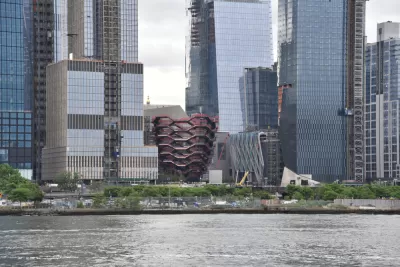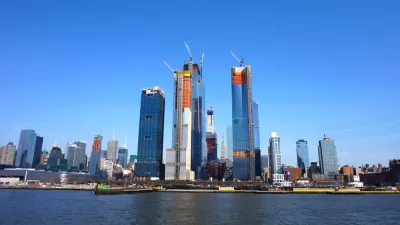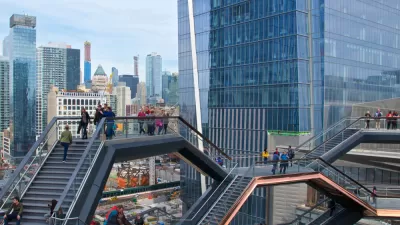The size and scale of Hudson Yards in the skyline of Manhattan will match the size and scale of public and private investment in the project. The project's effect in the city's economy will be just as conspicuous.

Greg David says there's a big angle to the story about the Hudson Yards project in New York City that is going unnoticed amidst a dispute between unions and developer The Related Cos.
The bigger story is the way Hudson Yards has—faster than anyone expected—fulfilled the two goals of the government officials who set it in motion: create capacity for the New York economy to expand and revive a moribund waterfront section of Manhattan. Its success can be attributed to more than $600 million in direct public investment and a very lucrative tax break.
The first phase of Hudson Yards, built with more than $18 billion in equity and debt over a storage and maintenance yard for Long Island Rail Road trains, will open to the public next March 14, Related says. The numbers couldn't be more impressive. The developer has leased or sold 7 million square feet of office space to tenants ranging from luxury accessories specialist Tapestry to ad agency BCG to media giant Time Warner to BlackRock, the largest money manager in the world. Some 55,000 thousand people will work there every day.
The article includes a history of the project, from its early days as a cornerstone in the Bloomberg Administration's pitch to bring the Olympics to New York City in 2012 (the games were ultimately played in London) to the big public investments that have set the stage for the success of Hudson Yards.
FULL STORY: The story of Hudson Yards is now the story of New York

Study: Maui’s Plan to Convert Vacation Rentals to Long-Term Housing Could Cause Nearly $1 Billion Economic Loss
The plan would reduce visitor accommodation by 25,% resulting in 1,900 jobs lost.

North Texas Transit Leaders Tout Benefits of TOD for Growing Region
At a summit focused on transit-oriented development, policymakers discussed how North Texas’ expanded light rail system can serve as a tool for economic growth.

Why Should We Subsidize Public Transportation?
Many public transit agencies face financial stress due to rising costs, declining fare revenue, and declining subsidies. Transit advocates must provide a strong business case for increasing public transit funding.

A Visual Celebration of Manhattan’s Chinatown Elder Community, Through Food
Lanterns, cafeteria trays, and community connection take center stage in this stunning photo essay.

How to Make US Trains Faster
Changes to boarding platforms and a switch to electric trains could improve U.S. passenger rail service without the added cost of high-speed rail.

Columbia’s Revitalized ‘Loop’ Is a Hub for Local Entrepreneurs
A focus on small businesses is helping a commercial corridor in Columbia, Missouri thrive.
Urban Design for Planners 1: Software Tools
This six-course series explores essential urban design concepts using open source software and equips planners with the tools they need to participate fully in the urban design process.
Planning for Universal Design
Learn the tools for implementing Universal Design in planning regulations.
City of Santa Clarita
Ascent Environmental
Institute for Housing and Urban Development Studies (IHS)
City of Grandview
Harvard GSD Executive Education
Toledo-Lucas County Plan Commissions
Salt Lake City
NYU Wagner Graduate School of Public Service





























